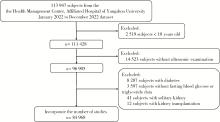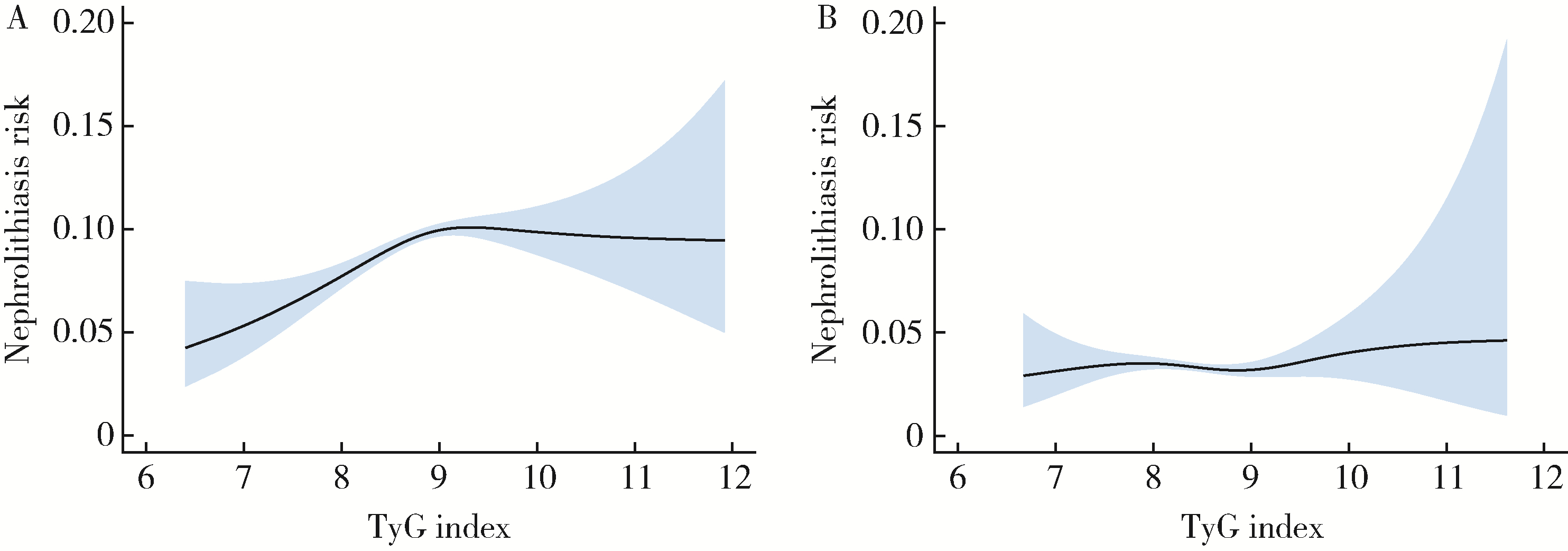Journal of Peking University (Health Sciences) ›› 2024, Vol. 56 ›› Issue (4): 610-616. doi: 10.19723/j.issn.1671-167X.2024.04.011
Previous Articles Next Articles
Association between the triglyceride-glucose index and the incidence of nephrolithiasis in male individuals
Shengqi ZHENG1,Tianchi HUA1,Guicao YIN1,Wei ZHANG1,Ye YAO2,*( ),Yifan LI1,*(
),Yifan LI1,*( )
)
- 1. Department of Urology, Affiliated Hospital of Yangzhou University, Yangzhou 225001, Jiangsu, China
2. Department of Hernia and Pediatric Surgery, Northern Jiangsu People's Hospital, Yangzhou 225001, Jiangsu, China
CLC Number:
- R692.4
| 1 |
Hill AJ , Basourakos SP , Lewicki P , et al. Incidence of kidney stones in the united states: The continuous national health and nutrition examination survey[J]. J Urol, 2022, 207 (4): 851- 856.
doi: 10.1097/JU.0000000000002331 |
| 2 |
Haas CR , Li G , Hyams ES , et al. Delayed decompression of obstructing stones with urinary tract infection is associated with increased odds of death[J]. J Urol, 2020, 204 (6): 1256- 1262.
doi: 10.1097/JU.0000000000001182 |
| 3 |
Khan SR , Pearle MS , Robertson WG , et al. Kidney stones[J]. Nat Rev Dis Primers, 2016, 2, 16008.
doi: 10.1038/nrdp.2016.8 |
| 4 |
Peerapen P , Thongboonkerd V . Kidney stone prevention[J]. Adv Nutr, 2023, 14 (3): 555- 569.
doi: 10.1016/j.advnut.2023.03.002 |
| 5 |
Fritz J , Bjørge T , Nagel G , et al. The triglyceride-glucose index as a measure of insulin resistance and risk of obesity-related cancers[J]. Int J Epidemiol, 2020, 49 (1): 193- 204.
doi: 10.1093/ije/dyz053 |
| 6 |
Lee SH , Park SY , Choi CS . Insulin resistance: From mechanisms to therapeutic strategies[J]. Diabetes Metab J, 2022, 46 (1): 15- 37.
doi: 10.4093/dmj.2021.0280 |
| 7 |
Kim S , Chang Y , Jung HS , et al. Glycemic status, insulin resistance, and the risk of nephrolithiasis: A cohort study[J]. Am J Kidney Dis, 2020, 76 (5): 658- 668. e1.
doi: 10.1053/j.ajkd.2020.03.013 |
| 8 |
Huo RR , Liao Q , Zhai L , et al. Interacting and joint effects of triglyceride-glucose index (TyG) and body mass index on stroke risk and the mediating role of TyG in middle-aged and older Chinese adults: A nationwide prospective cohort study[J]. Cardiovasc Diabetol, 2024, 23 (1): 30.
doi: 10.1186/s12933-024-02122-4 |
| 9 |
Xu L , Wu M , Chen S , et al. Triglyceride-glucose index associates with incident heart failure: A cohort study[J]. Diabetes Metab, 2022, 48 (6): 101365.
doi: 10.1016/j.diabet.2022.101365 |
| 10 |
Tao LC , Xu JN , Wang TT , et al. Triglyceride-glucose index as a marker in cardiovascular diseases: Landscape and limitations[J]. Cardiovasc Diabetol, 2022, 21 (1): 68.
doi: 10.1186/s12933-022-01511-x |
| 11 |
Xiang Q , Xu H , Zhan J , et al. Association between the trigly-ceride-glucose index and vitamin d status in type 2 diabetes mellitus[J]. Nutrients, 2023, 15 (3): 639.
doi: 10.3390/nu15030639 |
| 12 |
Wang S , Shi J , Peng Y , et al. Stronger association of triglyceride glucose index than the HOMA-IR with arterial stiffness in patients with type 2 diabetes: A real-world single-centre study[J]. Cardiovasc Diabetol, 2021, 20 (1): 82.
doi: 10.1186/s12933-021-01274-x |
| 13 |
Zhang Q , Xiao S , Jiao X , et al. The triglyceride-glucose index is a predictor for cardiovascular and all-cause mortality in CVD patients with diabetes or pre-diabetes: Evidence from NHANES 2001-2018[J]. Cardiovasc Diabetol, 2023, 22 (1): 279.
doi: 10.1186/s12933-023-02030-z |
| 14 | 艾比班木·艾则孜, 马依彤. 甘油三酯葡萄糖指数与心血管疾病及代谢综合征相关性的研究进展[J]. 中华老年多器官疾病杂志, 2022, 21 (4): 317- 320. |
| 15 |
Jiang H , Li L , Liu J , et al. Triglyceride-glucose index as a novel biomarker in the occurrence of kidney stones: A cross-sectional population-based study[J]. Int J Gen Med, 2021, 14, 6233- 6244.
doi: 10.2147/IJGM.S334821 |
| 16 |
Qin Z , Zhao J , Geng J , et al. Higher triglyceride-glucose index is associated with increased likelihood of kidney stones[J]. Front Endocrinol (Lausanne), 2021, 12, 774567.
doi: 10.3389/fendo.2021.774567 |
| 17 |
Chen L , Zhang J , Shen K , et al. Kidney stones are associated with metabolic syndrome in a health screening population: A cross-sectional study[J]. Transl Androl Urol, 2023, 12 (6): 967- 976.
doi: 10.21037/tau-23-51 |
| 18 |
Ye Z , Wu C , Xiong Y , et al. Obesity, metabolic dysfunction, and risk of kidney stone disease: A national cross-sectional study[J]. Aging Male, 2023, 26 (1): 2195932.
doi: 10.1080/13685538.2023.2195932 |
| 19 | Yuan S , Larsson SC . Assessing causal associations of obesity and diabetes with kidney stones using Mendelian randomization analysis[J]. Mol Genet Metab, 2021, 134 (1/2): 212- 215. |
| 20 | 王昱, 张慧敏, 邓雪蓉, 等. 尿枸橼酸定量检测在原发性痛风患者肾结石诊断中的应用价值[J]. 北京大学学报(医学版), 2022, 54 (6): 1134- 1140. |
| 21 |
Xu Z , Yao X , Duan C , et al. Metabolic changes in kidney stone disease[J]. Front Immunol, 2023, 14, 1142207.
doi: 10.3389/fimmu.2023.1142207 |
| 22 |
Deng J , Yu B , Chang Z , et al. Cerium oxide-based nanozyme suppresses kidney calcium oxalate crystal depositions via reversing hyperoxaluria-induced oxidative stress damage[J]. J Nanobiotechnology, 2022, 20 (1): 516.
doi: 10.1186/s12951-022-01726-w |
| 23 |
Khan SR , Canales BK , Dominguez-Gutierrez PR . Randall's plaque and calcium oxalate stone formation: Role for immunity and inflammation[J]. Nat Rev Nephrol, 2021, 17 (6): 417- 433.
doi: 10.1038/s41581-020-00392-1 |
| 24 |
Flisiński M , Brymora A , Skoczylas-Makowska N , et al. Fructose-rich diet is a risk factor for metabolic syndrome, proximal tubule injury and urolithiasis in rats[J]. Int J Mol Sci, 2021, 23 (1): 203.
doi: 10.3390/ijms23010203 |
| 25 |
Xu JZ , Li C , Xia QD , et al. Sex disparities and the risk of urolithiasis: A large cross-sectional study[J]. Ann Med, 2022, 54 (1): 1627- 1635.
doi: 10.1080/07853890.2022.2085882 |
| 26 |
Zhao JV , Schooling CM . Sex-specific associations of insulin resistance with chronic kidney disease and kidney function: A bi-directional Mendelian randomisation study[J]. Diabetologia, 2020, 63 (8): 1554- 1563.
doi: 10.1007/s00125-020-05163-y |
| 27 | Emami E , Heidari-Soureshjani S , Mohammadjavad AO , et al. Obesity and the risk of developing kidney stones: A systematic review and meta-analysis[J]. Iran J Kidney Dis, 2023, 1 (2): 63- 72. |
| 28 |
Inci M , Demirtas A , Sarli B , et al. Association between body mass index, lipid profiles, and types of urinary stones[J]. Ren Fail, 2012, 34 (9): 1140- 1143.
doi: 10.3109/0886022X.2012.713298 |
| 29 |
Kittanamongkolchai W , Mara KC , Mehta RA , et al. Risk of hypertension among first-time symptomatic kidney stone formers[J]. Clin J Am Soc Nephrol, 2017, 12 (3): 476- 482.
doi: 10.2215/CJN.06600616 |
| 30 |
Stamatelou K , Goldfarb DS . Epidemiology of kidney stones[J]. Healthcare, 2023, 11 (3): 424.
doi: 10.3390/healthcare11030424 |
| [1] | Huangda GUO,Hexiang PENG,Siyue WANG,Tianjiao HOU,Yixin LI,Hanyu ZHANG,Mengying WANG,Yiqun WU,Xueying QIN,Xun TANG,Jing LI,Dafang CHEN,Yonghua HU,Tao WU. A ssociations of short-term ambient particulate matter exposure and MTNR1B gene with triglyceride-glucose index: A family-based study [J]. Journal of Peking University (Health Sciences), 2024, 56(3): 375-383. |
| [2] | Meng-jie CUI,Qi MA,Man-man CHEN,Tao MA,Xin-xin WANG,Jie-yu LIU,Yi ZHANG,Li CHEN,Jia-nuo JIANG,Wen YUAN,Tong-jun GUO,Yan-hui DONG,Jun MA,Yi XING. Association between different growth patterns and metabolic syndrome in children and adolescents aged 7 to 17 years [J]. Journal of Peking University (Health Sciences), 2023, 55(3): 415-420. |
| [3] | Mei-ni ZUO,Yi-qing DU,Lu-ping YU,Xiang DAI,Tao XU. Correlation between metabolic syndrome and prognosis of patients with clear cell renal cell carcinoma [J]. Journal of Peking University (Health Sciences), 2022, 54(4): 636-643. |
| [4] | Xiao-yuan ZHANG,Cheng-cheng GUO,Ying-xiang YU,Lan XIE,Cui-qing CHANG. Establishment of high-fat diet-induced obesity and insulin resistance model in rats [J]. Journal of Peking University (Health Sciences), 2020, 52(3): 557-563. |
| [5] | Yong ZHANG,Chang LIU,Bin CHEN,Fan CHEN,Jin-yu DUAN,Meng-jun ZHANG,Jian JIAO. Associations of impaired glucose metabolism with chronic peridontitis in pre-diabetes patients [J]. Journal of Peking University(Health Sciences), 2020, 52(1): 71-76. |
| [6] | ZHANG Jin, XING Yan, WANG Xin-Li, GUAN Yu-Hong, ZHANG Hui. Decreased insulin sensitivity in rat hepatocytes with intrauterine growth retardation and establishment of insulin resistance cell model in vitro [J]. Journal of Peking University(Health Sciences), 2014, 46(3): 464-468. |
| [7] | LIU Miao, HE Yao, JIANG Bin, WU Lei, WANG Jian-Hua, YANG Shan-Shan, WANG Yi-Yan, LI Xiao-Ying. Relationship between brachial-ankle pulse wave velocity and metabolic syndrome among the elderly in a Beijing community and the gender difference [J]. Journal of Peking University(Health Sciences), 2014, 46(3): 429-434. |
| [8] | YAN Rui, LUAN Qing-Xian, LIU Li-Sheng, WANG Xing-Yu, LI Peng, SHA Yue-Qin. Association between chronic periodontitis and metabolic syndrome related mitochondria single nucleotide polymorphism [J]. Journal of Peking University(Health Sciences), 2014, 46(2): 264-268. |
|
||



